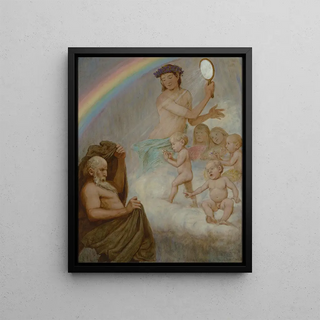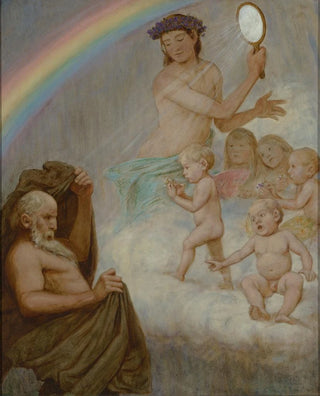Art print | Avril, la déesse du printemps, aveugle l'hiver - Hans Thoma


View from behind

Frame (optional)
Avril, the goddess of spring, blinds winter - Hans Thoma – Captivating introduction
In a world where each season tells a story, the artwork "April, the goddess of spring, blinds winter" by Hans Thoma stands out as a vibrant celebration of spring's rebirth. This painting, a true ode to nature, captures the magical moment when spring's light pushes back the shadows of winter. The scene, imbued with poetry and delicacy, transports us to a universe where the goddess, a symbol of renewal, emerges gracefully, illuminating the landscape with vivid colors and life. Through this piece, Thoma invites us to feel the power of nature and to contemplate the fleeting beauty of the seasonal cycle.
Style and uniqueness of the artwork
Hans Thoma's style is distinguished by its symbolist approach, blending realism with dreamlike elements. In "April, the goddess of spring, blinds winter," he uses a palette of shimmering colors that evoke freshness and vitality of spring. The soft, flowing forms of the characters, as well as the meticulous details of flowers and foliage, demonstrate a deep respect for nature. The goddess, at the center of the composition, is depicted with a serene and powerful expression, while winter, represented by shadows and cool tones, seems to retreat in the face of her brightness. This duality between light and darkness, between life and death, gives the artwork an almost mythological dimension, where spring triumphs inexorably over winter.
The artist and his influence
Hans Thoma, born in 1839, is an emblematic figure of the 19th-century German artistic movement. Influenced by Romantic and Symbolist currents, he develops a unique style that combines tradition and innovation. His passion for nature and Germanic myths is reflected in his works, where he seeks to express human emotions through enchanting landscapes and mythological characters. Thoma managed to establish himself on the European art scene, notably through his vibrant representations of rural life and popular legends. His influence endures today, inspiring many contemporary artists to explore the relationship between

Matte finish

View from behind

Frame (optional)
Avril, the goddess of spring, blinds winter - Hans Thoma – Captivating introduction
In a world where each season tells a story, the artwork "April, the goddess of spring, blinds winter" by Hans Thoma stands out as a vibrant celebration of spring's rebirth. This painting, a true ode to nature, captures the magical moment when spring's light pushes back the shadows of winter. The scene, imbued with poetry and delicacy, transports us to a universe where the goddess, a symbol of renewal, emerges gracefully, illuminating the landscape with vivid colors and life. Through this piece, Thoma invites us to feel the power of nature and to contemplate the fleeting beauty of the seasonal cycle.
Style and uniqueness of the artwork
Hans Thoma's style is distinguished by its symbolist approach, blending realism with dreamlike elements. In "April, the goddess of spring, blinds winter," he uses a palette of shimmering colors that evoke freshness and vitality of spring. The soft, flowing forms of the characters, as well as the meticulous details of flowers and foliage, demonstrate a deep respect for nature. The goddess, at the center of the composition, is depicted with a serene and powerful expression, while winter, represented by shadows and cool tones, seems to retreat in the face of her brightness. This duality between light and darkness, between life and death, gives the artwork an almost mythological dimension, where spring triumphs inexorably over winter.
The artist and his influence
Hans Thoma, born in 1839, is an emblematic figure of the 19th-century German artistic movement. Influenced by Romantic and Symbolist currents, he develops a unique style that combines tradition and innovation. His passion for nature and Germanic myths is reflected in his works, where he seeks to express human emotions through enchanting landscapes and mythological characters. Thoma managed to establish himself on the European art scene, notably through his vibrant representations of rural life and popular legends. His influence endures today, inspiring many contemporary artists to explore the relationship between






